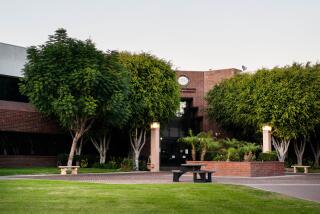Former surgeon general addresses graduates at Drew medical school
- Share via
Encouraged by new healthcare reform legislation, former U.S. Surgeon General Dr. David G. Satcher spoke to graduates Saturday at the Charles Drew University of Medicine and Science about the importance of preventive care and urged them to “continue to dream about the future of healthcare — the way it needs to be.”
“President Obama has provided great leadership in getting the passage of healthcare reform,” Satcher said at the school’s commencement ceremony. “But that’s not the end. That’s the beginning. It’s gonna be up to us to see that the system is reformed in the right manner.”
Satcher, 69, pointed out that Medicare spends 80% of its budget treating chronic diseases such as diabetes. He said more money should be spent on preventing illnesses.
“This is no time to stop dreaming,” Satcher said.
When Satcher graduated from medical school in 1970, he said, about 10% of the U.S. population was obese. By 2001, more than 30% was obese, and an additional was 30% overweight.
“We continue to struggle,” Satcher said.
Saturday’s commencement was a homecoming for Satcher, who served as interim dean between 1977 and 1979 at what was then the Charles R. Drew Postgraduate Medical School. The school was created after the 1965 Watts riots to train minority physicians to serve an area in desperate need of healthcare services.
Satcher was an architect of the agreement to open a medical school at Drew. Students attend UCLA for two years, then finish up their final two years at Drew.
Also Saturday, Satcher announced the establishment of an endowed scholarship that honors his mentor, Dr. M. Alfred Haynes, a former Drew president. So far, the endowment is up to $80,000.
“I know Drew has problems, but we were trying to express confidence and support and honor one of the outstanding people in the history of Drew,” Satcher said in an earlier interview.
Much has changed at the university since Satcher arrived there as a community medicine fellow in 1972.
Haynes’ first assignment for Satcher, then 31, was to win a highly competitive grant from the National Institutes of Health to study sickle cell anemia, an inherited blood disorder affecting 1 in 500 African Americans.
It was rare for someone so young to take on such a critical assignment. But Haynes had to leave on a three-month trip to India, so Satcher was on his own.
Nonetheless, “we did it,” Satcher said.
Satcher went on to a successful career — chairing a department at the Morehouse School of Medicine in Atlanta until 1982, then becoming president of Meharry Medical College in Nashville before he was tapped to direct the U.S. Centers for Disease Control and Prevention in 1993. He served as U.S. Surgeon General from 1998 to 2002.
Back in Willowbrook, Drew had fallen into crisis. In 2002 and 2003, the school was told it would lose its ability to train radiologists and general surgeons.
In 2003, Satcher was asked by the Los Angeles County Board of Supervisors to review the situation and propose solutions. He returned with a scathing critique of the university, saying it required a “culture of accountability.”
Change, however, was difficult because the university was linked to the troubled Martin Luther King Jr./Drew Medical Center. In 2006 the county severed its ties to the university, forcing the school to stop training physicians after they graduated from medical school.
The campus remains in turmoil. Last year, an accreditation agency placed Drew on probation and its president, Susan Kelly, left after receiving a vote of no-confidence from the Academic Senate. It also faces financial problems.
Satcher said he believes Drew is still able to fulfill its core mission, but with some difficulty. Later this summer, Drew is planning to open a nursing school.
“It’s not easy at all,” Satcher said. “It’s clearly not the same situation, with the closing of the hospital and all the problems surrounding it.”
Still, he added, “Drew is graduating doctors, and I think many of them are motivated to serve in underserved communities.”
The reality is that it’s difficult to provide quality care in an impoverished neighborhood, Satcher said.
“That’s not to make excuses. … The reality is, it’s a struggle,” he said.







